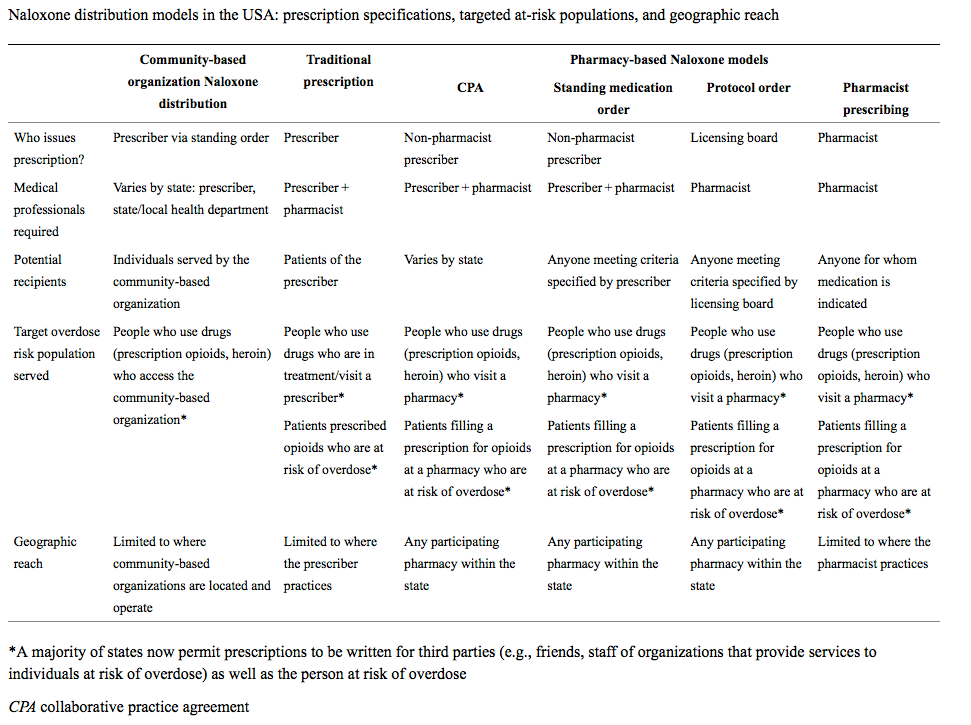Article
How Are Pharmacists Providing Naloxone to Patients?
Author(s):
Placing the opioid overdose antidote naloxone behind pharmacy counters across the United States could provide a catalyst for pharmacists to play a central role as facilitators for drug addiction treatment.
Placing the opioid overdose antidote naloxone behind pharmacy counters across the United States could provide a catalyst for pharmacists to play a central role as facilitators for drug addiction treatment.
Several states have started to position pharmacists this way through collaborative practice agreements and standing orders for pharmacy-based naloxone distribution, respectively. One recent research article published in the Harm Reduction Journal outlined current models in 2 such states that could serve as frameworks for the rest of the country.

In Rhode Island, a collaborative pharmacy practice agreement for naloxone facilitates pharmacist-initiated prescription and provision of the opioid overdose antidote to eligible patients.
Under Rhode Island Board of Pharmacy regulations formalized in 2014, participating patients must consent to the exchange of information between their pharmacist and prescriber, receive a handout with overdose education, and then check-in with the pharmacist, who verifies their understanding of naloxone use before it is dispensed.
Pharmacist participation in the naloxone collaborative practice agreement requires 1 hour of continuing professional education annually. As of June 2015, 363 pharmacists—96% of whom were employed by retail chain pharmacies in the state—had completed this training through the University of Rhode Island’s online program.
Jeffrey Bratberg, PharmD, co-chair of the Rhode Island Pharmacists Association’s legislative committee, told Pharmacy Times that the state’s pharmacists are now “work[ing] more closely with providers and their patients to increase awareness of overdose risk and to increase community protection from opioid overdose death by greatly increasing access to naloxone, particularly to those who do not know their risk.”
Forty-eight states (including Rhode Island) allow pharmacists to enter into collaborative practice agreements with prescribers to manage patient pharmaceutical care, and at least 21 states permit pharmacists to initiate medication therapy under such agreements, according to the American Pharmacists Association.
Massachusetts has taken a different yet equally effective approach to pharmacy-based naloxone distribution. In response to the governor declaring a public health emergency regarding opioid overdose, the Massachusetts Board of Registration in the Pharmacy and the state’s Drug Control Program adopted regulations in 2014 authorizing pharmacists to dispense naloxone under a standing order signed by a physician. These provisions expanded the state’s existing collaborative practice agreement regulations, which had only permitted pharmacists to dispense naloxone to established patients of the prescriber.
A pharmacy standing order is similar to a collaborative practice agreement in terms of implementation and intended reach. It must be signed by a physician and the pharmacy manager at each outlet, and then copies must be filed with the pharmacy board and maintained onsite at the pharmacy.
Just like collaborative practice agreements, pharmacists with standing orders must have an understanding of the appropriate use of naloxone and counsel of the patient while including an overdose prevention information sheet within the naloxone prescription. Between March and December 2014, 145 retail pharmacies in Massachusetts filed a naloxone pharmacy standing order with the state pharmacy board.
“With an unprecedented number of opioid overdoses globally, an expanding pool of opioid use initiates in the US, and an aging baby boomer generation with high lifetime drug use and high burdens of chronic pain often treated with opioids, it is imperative that creative, sustainable solutions…are implemented,” the researchers concluded. “Pharmacy-based naloxone is one public health intervention that better leverages pharmacies’ capacity and pharmacists’ skills.”






